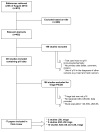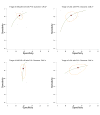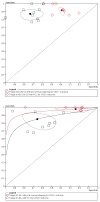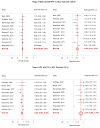p16INK4a immunocytochemistry versus human papillomavirus testing for triage of women with minor cytologic abnormalities: a systematic review and meta-analysis
- PMID: 22700382
- PMCID: PMC4198379
- DOI: 10.1002/cncy.21205
p16INK4a immunocytochemistry versus human papillomavirus testing for triage of women with minor cytologic abnormalities: a systematic review and meta-analysis
Abstract
The best method for identifying women who have minor cervical lesions that require diagnostic workup remains unclear. The authors of this report performed a meta-analysis to assess the accuracy of cyclin-dependent kinase inhibitor 2A (p16(INK4a)) immunocytochemistry compared with high-risk human papillomavirus DNA testing with Hybrid Capture 2 (HC2) to detect grade 2 or greater cervical intraepithelial neoplasia (CIN2+) and CIN3+ among women who had cervical cytology indicating atypical squamous cells of undetermined significance (ASC-US) or low-grade cervical lesions (LSIL). A literature search was performed in 3 electronic databases to identify studies that were eligible for this meta-analysis. Seventeen studies were included in the meta-analysis. The pooled sensitivity of p16(INK4a) to detect CIN2+ was 83.2% (95% confidence interval [CI], 76.8%-88.2%) and 83.8% (95% CI, 73.5%-90.6%) in ASC-US and LSIL cervical cytology, respectively, and the pooled specificities were 71% (95% CI, 65%-76.4%) and 65.7% (95% CI, 54.2%-75.6%), respectively. Eight studies provided both HC2 and p16(INK4a) triage data. p16(INK4a) and HC2 had similar sensitivity, and p16(INK4a) has significantly higher specificity in the triage of women with ASC-US (relative sensitivity, 0.95 [95% CI, 0.89-1.01]; relative specificity, 1.82 [95% CI, 1.57-2.12]). In the triage of LSIL, p16(INK4a) had significantly lower sensitivity but higher specificity compared with HC2 (relative sensitivity, 0.87 [95% CI, 0.81-0.94]; relative specificity, 2.74 [95% CI, 1.99-3.76]). The published literature indicated the improved accuracy of p16(INK4a) compared with HC2 testing in the triage of women with ASC-US. In LSIL triage, p16(INK4a) was more specific but less sensitive.
Copyright © 2012 American Cancer Society.
Figures




Comment in
-
p16INK4a-is the future of cervical cancer screening rosy?Cancer Cytopathol. 2012 Oct 25;120(5):291-3. doi: 10.1002/cncy.21206. Epub 2012 Jun 14. Cancer Cytopathol. 2012. PMID: 22700399 No abstract available.
Similar articles
-
Human papillomavirus testing versus repeat cytology for triage of minor cytological cervical lesions.Cochrane Database Syst Rev. 2013 Mar 28;2013(3):CD008054. doi: 10.1002/14651858.CD008054.pub2. Cochrane Database Syst Rev. 2013. PMID: 23543559 Free PMC article.
-
Cytology versus HPV testing for cervical cancer screening in the general population.Cochrane Database Syst Rev. 2017 Aug 10;8(8):CD008587. doi: 10.1002/14651858.CD008587.pub2. Cochrane Database Syst Rev. 2017. PMID: 28796882 Free PMC article.
-
Meta-analysis of the accuracy of p16 or p16/Ki-67 immunocytochemistry versus HPV testing for the detection of CIN2+/CIN3+ in triage of women with minor abnormal cytology.Cancer Cytopathol. 2019 Mar;127(3):169-180. doi: 10.1002/cncy.22103. Epub 2019 Feb 27. Cancer Cytopathol. 2019. PMID: 30811902
-
The triage of low-grade cytological abnormalities by the immunocytological expression of cyclin-dependent kinase inhibitor p16INK4a versus Human Papillomavirus test: a real possibility to predict cervical intraepithelial neoplasia CIN2 or CIN2+.Rom J Morphol Embryol. 2013;54(4):1061-5. Rom J Morphol Embryol. 2013. PMID: 24399002
-
The APTIMA HPV assay versus the Hybrid Capture 2 test in triage of women with ASC-US or LSIL cervical cytology: a meta-analysis of the diagnostic accuracy.Int J Cancer. 2013 Jan 1;132(1):101-8. doi: 10.1002/ijc.27636. Epub 2012 Jun 13. Int J Cancer. 2013. PMID: 22610699 Review.
Cited by
-
Human Papillomavirus Laboratory Testing: the Changing Paradigm.Clin Microbiol Rev. 2016 Apr;29(2):291-319. doi: 10.1128/CMR.00013-15. Clin Microbiol Rev. 2016. PMID: 26912568 Free PMC article. Review.
-
Prognostic significance of overexpressed p16INK4a in patients with cervical cancer: a meta-analysis.PLoS One. 2014 Sep 4;9(9):e106384. doi: 10.1371/journal.pone.0106384. eCollection 2014. PLoS One. 2014. PMID: 25188353 Free PMC article.
-
Viral and cellular biomarkers in the diagnosis of cervical intraepithelial neoplasia and cancer.Biomed Res Int. 2013;2013:519619. doi: 10.1155/2013/519619. Epub 2013 Dec 9. Biomed Res Int. 2013. PMID: 24383054 Free PMC article. Review.
-
The Application of Classification and Regression Trees for the Triage of Women for Referral to Colposcopy and the Estimation of Risk for Cervical Intraepithelial Neoplasia: A Study Based on 1625 Cases with Incomplete Data from Molecular Tests.Biomed Res Int. 2015;2015:914740. doi: 10.1155/2015/914740. Epub 2015 Aug 3. Biomed Res Int. 2015. PMID: 26339651 Free PMC article.
-
Cervical intraepithelial neoplasia in pregnancy: Interference of pregnancy status with p16 and Ki-67 protein expression.Oncol Lett. 2017 Jan;13(1):301-306. doi: 10.3892/ol.2016.5441. Epub 2016 Nov 29. Oncol Lett. 2017. PMID: 28123559 Free PMC article.
References
-
- Arbyn M, Castellsagué X, de Sanjosé S, et al. Worldwide burden of cervical cancer in 2008. Ann Oncol. 2011;22:2675–86. - PubMed
-
- Arbyn M, Rebolj M, de Kok IM, et al. The challenges for organising cervical screening programmes in the 15 old member states of the European Union. Eur J Cancer. 2009;45:2671–8. - PubMed
-
- Solomon D, Schiffman MA, Tarone B. Comparison of three management strategies for patients with atypical squamous cells of undetermined significance (ASCUS): baseline results from a randomized trial. J Natl Cancer Inst. 2001;93:293–9. - PubMed
-
- Arbyn M, Buntinx F, Van Ranst M, et al. Virologic versus cytologic triage of women with equivocal Pap smears: a meta-analysis of the accuracy to detect high-grade intraepithelial neoplasia. J Natl Cancer Inst. 2004;96:280–93. - PubMed
-
- Arbyn M, Sasieni P, Meijer CJ, et al. Chapter 9: Clinical applications of HPV testing: a summary of meta-analyses. Vaccine. 2006;24(SUPPL 3):S78–S89. - PubMed
Publication types
MeSH terms
Substances
Grants and funding
LinkOut - more resources
Full Text Sources
Medical
Research Materials
Miscellaneous

